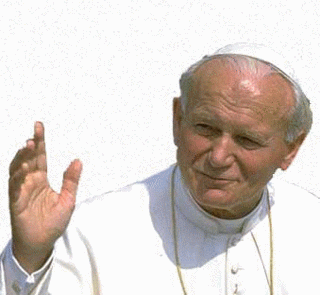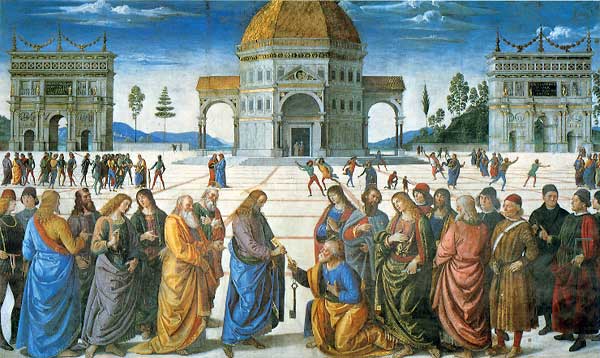 Last time we dealt with the first part of a two-part query from a reader. Now for part two.
Last time we dealt with the first part of a two-part query from a reader. Now for part two.
The question is: How useful can a particular quotation from Vatican I be in dealing with sedevacantists (i.e., those who say there is no valid pope at present)—particularly those who say that Pius XII was the last valid pope.
The quotation from Vatican I is:
[I]f anyone says that it is not by the institution of Christ the Lord himself (that is to say, by divine law) that blessed Peter should have perpetual successors in the primacy over the whole Church; or that the Roman pontiff is not the successor of blessed Peter in this primacy: let him be anathema.
Since the time of Vatican I the canonical penalty of anathema—which was a special kind of excommunication done with a particular ceremony—has been abolished, so nobody today is under the penalty of anathema even if they do violate this canon.
However, this canon defines a point that appears to be divinely revealed. The obstinate doubt or denial of a doctrine that is both divinely revealed and infallibly defined by the Church as such is a heresy, and thus under certain conditions a Catholic who falls afoul of this canon can indeed excommunicate himself (and automatically so). This just isn’t the kind of excommunication formerly known as anathema.
So much for the canonical aspects. What about its utility as an argument when dealing with sedevacantists?
To assess that, we first need to understand what is being defined in this text. And we have to do that rather carefully, because infallible definitions must be construed narrowly. Thus the Code of Canon Law provides:
Canon 749 §3. No doctrine is understood as defined infallibly unless this is manifestly evident.
One results of this is that we must ask what the council was trying to define. If it is manifestly evident that a particular proposition was intended then that proposition is defined infallibly. If it is not manifestly evident then it is not to be regarded as infallibly defined.
In the case of the Vatican I statement quoted above, the purpose of the council was to define that it was “by the institution of Christ the Lord himself (that is to say, by divine law) that blessed Peter should have perpetual successors in the primacy over the whole church.” In other words, the papacy is not a man-made thing. It is not by human or merely ecclesiastical law that there be an ongoing line of successors to St. Peter with jurisdiction over the whole church. (The council also identified the bishop of Rome as that successor, but this isn’t the point that concerns us here.)
It is manifestly evident that the council wished to say that Christ’s intention that St. Peter would have an ongoing line of successors with primacy over the whole Church, but this does not mean that there would be a successor at any particular moment.
There obviously isn’t a successor during the “interregnum” (between the reigns) period between the death of one pope and the election of another. Sometimes these interregna have even lasted years, when the college of cardinals had trouble making up its mind (though that hasn’t happened in a very long time; that’s why the conclave was invented, so that the cardinals would be effectively locked up together until they came up with a successor).
So if the passage from Vatican I does not ensure that there will be a successor at any particular moment then a sedevacantist could simply argue that now is one of those moments. Something either went wrong with a recent papal election, in such a way that invalidated it, or—according to one theory that at least some thinkers in Catholic history have advocated—a pope could forfeit his office through heresy.
One of these two things is, in fact, what sedevacantists claim. So I don’t see the text from Vatican I as being a useful argument against sedevacantism in general, but there is another possibility. Might it work against a specific form of sedevacantism?
According to many current sedevacantists, Pius XII was the last valid pope. He died in 1958, which was 53 years ago.
Here is where the argument gets interesting: In order to be pope, under current canon law, one must be elected by the college of cardinals. In order to be a member of the college of cardinals, one must be appointed by the pope. In order for the pope to appoint you, he must be alive.
If the last valid pope died in 1958, that would seem to mean that no cardinals have been validly appointed since then. How many cardinals are alive today who were appointed before 1958?
None.
The longest-serving cardinal at present is Eugenio Sales, who wasn’t appointed until 1969. If his elevation to the cardinalate was invalid, and so were all subsequent elevations due to a lack of valid popes, then it would appear that the college of cardinals now has no members. With no valid members, it would seem impossible for there to be another validly elected pope.
Ever.
That would be odd.
It would certainly seem to be contrary to the will of Christ who, in the words of Vatican I, willed “that blessed Peter should have perpetual successors in the primacy over the whole Church.” If Christ really wills that there be an ongoing series of successors then one would think he would keep the Church from getting into a position where it is impossible to elect any more successors.
So do we have a good argument here, from Vatican I, after all? An argument that deals a death-blow to a major current form of sedevacantism?
Let’s think about what responses a sedevacantist (of the requisite type) might make. What avenues of counter-argument might he have?
For a start, he would be able to say, “Hey, I agree with that Vatican I said. I think Christ did will that St. Peter have ongoing successors to the end of time (with gaps here and there). It’s not Christ’s will that we currently be without a pope. It’s a tragedy that we are!”
Responding to this, one might say, “Okay, but then how are we supposed to get a new pope?”
Here the sedevacantist would seem to have two options: (1) He could bite the bullet and say that there just is no way to get a new pope; we’re just stuck. Or (2) he could say that there is, in fact, a way to get a new pope, despite what you might otherwise thing.
If he picks option (1), do we have him?
I don’t think so. At least not based on what Vatican I says. The reason is this: God can will things in different senses.
He can, on the one hand, will that certain things happen or not happen in what’s sometimes called a “preceptive” way. That is, he establishes a precept that things happen (Honor thy father and mother) or that they not happen (Thou shalt not bear false witness). But it’s clear that when God wills something preceptively, that doesn’t mean it’s going to come to pass. People dishonor their fathers and mothers all the time. They bear false witness all the time.
On the other hand, God can will that certain things happen or not happen in what’s sometimes called an “efficacious” way. That is, he not only wills that they happen but he arranges circumstances so that they do in fact happen. This is the case, for example, when a pope or a council speaks infallibly. God wills that when certain conditions are fulfilled, the resulting teaching will be infallible, and he brings it about that the teaching is infallible. If a pope or council were to try to define something that is false, something (pleasant or unpleasant) would happen to stop this from happening.
So one question we have to face is: What kind of willing is being talked about in the text from Vatican I?
For a variety of reasons, a very strong case can be made that it’s the first. Let me give you just one reason: In its historical context, Vatican I was dealing with people who had argued that the papacy is a man-made institution, not one that exists by the will of Christ or by divine law. That was the point this particular text was dealing with.
It was not responding to people who claimed that the papacy is a divine institution but it might not endure to the end of the world—with gaps here and there (due, at least, to interregna), but with a guaranteed new successor before the end of the world and alive at the time Christ comes back.
The latter claim does not appear to be what the council was attempting to define. As a result, it is not manifestly evident that the council defined this teaching, and so—according to the 1983 Code of Canon Law—we should not regard this teaching as having been infallibly defined.
The sedevacantist thus can say, “You’re overreaching with the text from Vatican I. It’s just an affirmation that it’s the preceptive will of Christ that there be ongoing successors to Peter—not a guarantee that there will be one alive at the time of the Second Coming.”
I think this is a valid response. I don’t think we can get from the text of Vatican I an infallible definition of the proposition that there will be a living success of Peter at the very end. We might believe this on other grounds, but it’s not what Vatican I was attempting to define, and thus it’s not something Vatican I defined.
If one can produce other grounds that guarantee a living successor of Peter at the Second Coming then it is those grounds—not Vatican I—that one should point to.
The idea that there would not be a living successor of Peter at the end of time is a very uncomfortable thought—so uncomfortable, in fact, that many sedevacantists would not want to go in this direction and would instead pick option (2) and claim that there is a way to get a new pope, despite what one might think.
What might a sedevacantist of this sort claim?
I can think of several possibilities off the top of my head:
a) There was a secret conclave before the last valid cardinals died, and there is a continuing papacy that is little known or in secret.
b) God could make a new pope known by divine (and presumably private) revelation.
c) In the absence of a valid set of cardinals, and the impossibility of generating new ones, the ecclesiastical law providing for the election of a pontiff by the college of cardinals has lapsed, making it possible to elect a new pope through some other means (such as by a tiny remnant of the “true faithful,” whether they be conceived of as bishops, priests, laypeople, or some mix of those).
In fact, variations on these the proposals are what some sedevacantists claim. In fact, some have already proposed new anti-popes citing one or another of these as the basis. (In fact, I’ve had more than one current anti-pope ask to friend me on Facebook, though I have declined these invitations since I strongly suspected it was just a ploy to get in front of my FB friends to promote their anti-papacies.) This means that they and their followers aren’t technically sedevacantists but schismatics following a false pope.
A sedevacantist could even say, “I don’t know what the method is for getting a new pope, but there must be one.”
In fact, a sedevacantist could even site the very same text from Vatican I and—again taking it beyond what the council was attempting to define—argue that this text shows that there must be a way of getting a new pope, even though it isn’t presently clear what that is.
So I don’t think that the Vatican I text is a knock-down argument against sedevacantism, even of the sort that sees Pius XII as the last valid pope.
That’s not to say it’s useless. It does, after all, show that it’s at least the preceptive will of Christ that Peter have ongoing successors, and if that’s the case then it’s reasonable to suppose, hope, and think that in a matter this important he would guide the Church in such a way that we don’t get into a no-pope-ever-again situation. But this is only one datapoint in a larger argument that must be mounted.
I think there is quite a bit of fruitful material to be mined in the area we are exploring—the implications of the will of Christ for the ongoing nature of the papacy—and how this ill-fits with the claim that the papacy has been vacant for more than half a century. The cognitive dissonance created by that idea, plus the lameness of the alternative ways of getting a pope mentioned above (each of which is fraught with problems) makes a powerful case that the sedevacantists are simply wrong, and profoundly so.
But I think in order to make that case we need to appeal to a broader array of evidence and that the text from Vatican I doesn’t settle the matter for us, as great as that would be.
What do you think?






